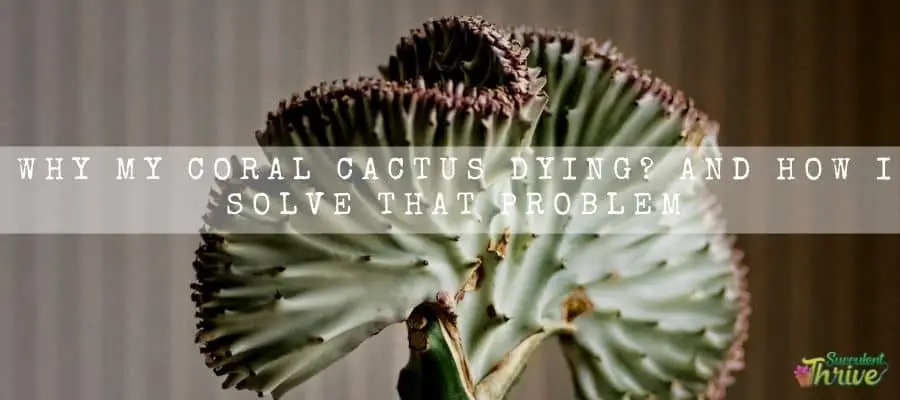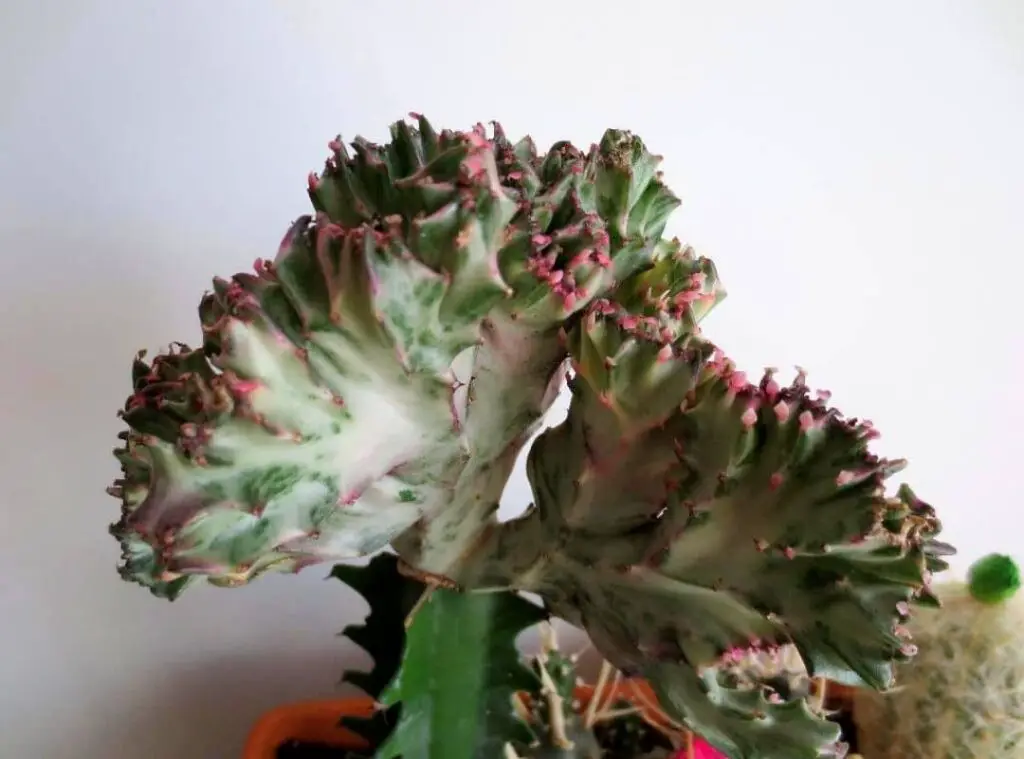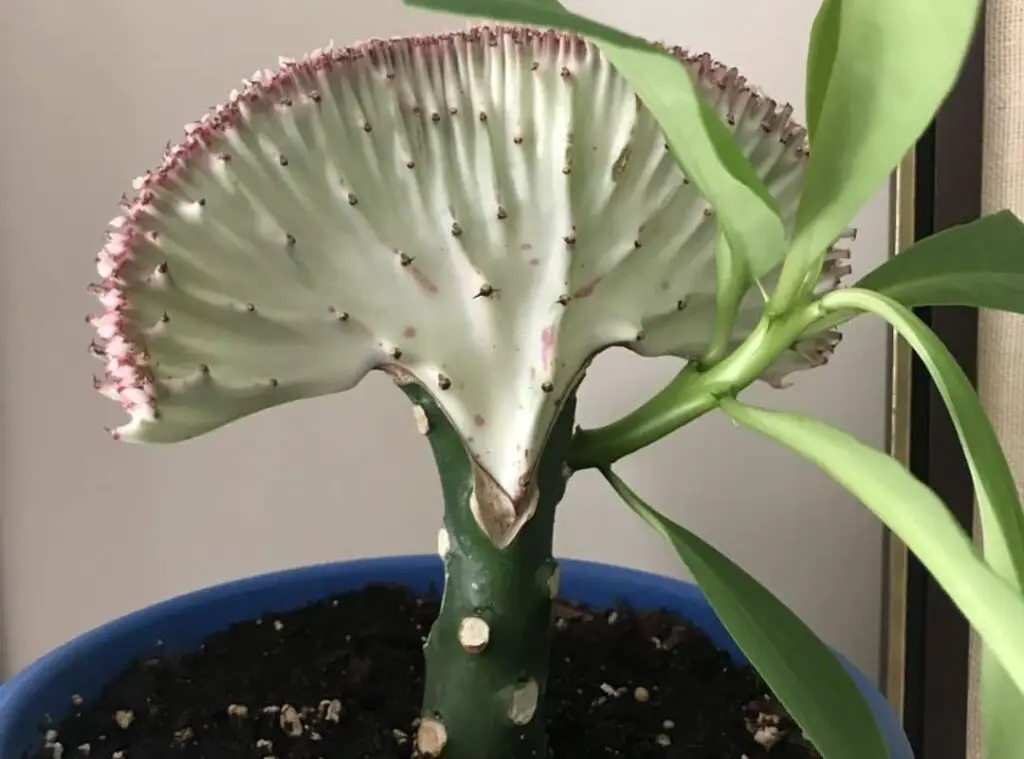If you spot your coral cactus turning their leaves into yellow faster, and if you come across any brown base along with stunt growth, those are the indications of a coral cactus dying.
In that circumstance, you need to immediately remove the plants out of the pots and observe the plants closely.
Check whether the roots are yellow or whether they are brown and mushy when you touch it.
If the roots are brown and mushy when you touch it, you need to act immediately and do the needful to treat the plants.
And find much more information about coral cactus dying in this article.

Why is my coral cactus dying?
If you expose your coral cactus for excess lighting levels and intense extremely heated temperatures, those conditions will lead the plants to die.
In addition to that the faults you do when watering the plants could also cause your beloved coral cactus to perish.
Apart from that if you fail to provide a well-draining soil mix, it will also lead the plants to stay in waterlogged conditions and lead to root rot.
How do you save a dying coral cactus?
First and foremost, you could consider snipping off the rotten parts away from the plants.
Over watering is what usually causes your plants to rot and die. If you spot any brown or black sections of your plants, you need to immediately get rid of them.
After that, it would be better if you could plant them in a new pot and in a fresh soil mix. Alternatively, you could let the plant wither and start watering as you used to do.
Ensure that they get adequate sunlight levels. If your plants are exposed to excess sunlight or for less sunlight levels, it would affect the plant health to deteriorate.
As such I recommend rotating the plant on a weekly basis so that the entire plant gets sunlight evenly.
Next, you need to adjust watering when you are trying to save your coral cactus.
If you could spot your cactus has become wrinkled, it is an indication to let you know that your plants are lacking sufficient water.
Make sure that the soil is dry between two watering sessions so that you could avoid any over watering which could lead to any potential root rot.
Ensure that your pot has at least one draining hole so that there will not be any water pools remaining in the pots.
Further you should water them more often in summer and in spring as those are their actively growing seasons.
On the other hand, you need to cut back on watering them in winter and do it less often.
Apart from these, you could consider rinsing off their dust and dirt. Further you need to watch out for the pests and insects since they could also create trouble for your beloved plants.
If you encounter any pests’ attacks with the plants, I urge you to use insecticides and pesticides to treat them.
Instead of that you may also use rubbing alcohol too, especially during a mealybug attack.

Can a coral cactus come back to life?
Coral cactus could revive if you repot them and if you knock away the infected soil and provide them disinfected soil instead.
Do not forget to wash the roots well before you replant them in the fresh soil mix. In addition to that you could use their healthy plant parts for the propagation process and make new plants.
That will allow the plants to get a fresh start.
Why is my coral cactus rotting?
Over watering could attribute the coral cactus to rot. In those situations, you should let them dry first.
Coral cactus require a minimal water amount to survive and excess water could be so unhealthy for them. Hence why it is critical to water adequately.
You may spot mushy and brown parts of the cactus when they are rotting. These are the signs which indicate to you that your cactus is rotting.
All you need to do to overcome this situation is not to over water them and adhere to the regular cactus watering guidelines when watering them.
Apart from over watering, pests’ attacks could also result in rotting of the plants.
Will an overwatered cactus recover?
It is very unlikely that it will survive if you have over-watered them in excessive amounts as it would lead for rotting of the plants.
Once root rot takes place in your plants, it is very unlikely you could save the plants. However, you could consider repotting them if the root rot has not spread on a severe level.
You simply need to remove the rotten plant parts and replant them in a fresh soil mix. If the root rot has spread on a severe level, you could consider propagating the healthy plant parts.
How do you tell if a cactus is over or under watered?
If you spot your cactus has formed curled or shriveled leaves, that could be a sign of under watering.
It could be harmful for the plants particularly if you have grown them in bright sunny spots and provided them a little water.
Further if you spot the plant root ball has become smaller it could also be a sign of under watering. If you spot your cactus is dry, you need to immediately consider watering them.
On the other hand, if you had over-watered the plants, you could see yellowing of the plants.
Further you will see how they become mushy too. In that circumstance you should cut back on watering and let them dry.
Why is my cactus drooping?
If your cactus is in stress, it could start drooping.
It could be due to improper way of watering them, inadequate sunlight levels etc. in addition to that frost damage, mealy bugs attacks could also result in the drooping of the plants.
If I elaborate further on the improper watering, it would be somewhat difficult to determine the exact water levels your plants need.
If your plants are dehydrated, you would see how your cactus become soft and discolored. Over time, it will tend to look in a wrinkly appearance as well.
Ultimately it will start to droop and cause root rot as well.
It is vital that you grow the coral cactus in a well-draining soil mix so that it will help the plants to resolve dehydration.
Further you could consider repotting the plants to overcome this issue too. Consider that you have over-watered your plants, you need to dry out the plants and water them once they are dry only.
Keep in mind that coral cactus needs to be watered only if their top layer of the soil is dry. Once you water, ensure that you do it thoroughly and do not let any excess moisture retain in the pot.
As aforesaid mealybugs could be another factor which could attribute your plants for dropping. You could spot the mealybugs in white and they could be spotted as cottony substances.
They depend on the plant’s sap and tend to spread faster among other plants as well. When they consume the sap of the plants on a greater level it could lead to dropping.
You could treat them by rinsing the cactus whilst using insecticidal soap or liquid soap. Ensure that you let them dry after rinsing them. Alternatively you could kill them manually.
If you expose them to inadequate sunlight levels, it could also lead to the drooping of the coral cactus. Cactus in general is fond of strong sunlight levels and warmer temperatures.
If you have watered the cactus properly and no pest’s invasion is visible, it could most probably be due to lack of sunlight.
If you spot this condition particularly during winter, you need to provide them additional light by placing a grow light closer to the plants.

Is my cactus dehydrated?
If you spot your cactus appear to be wrinkly and soft, it could be an indication of a dehydrated cactus.
In addition to that if you feel their spines are dry and tend to drop at the slightest touch, they could also be indications of dehydrated plants.
Further if your cactus is dehydrated chances are that they will shrivel and start to discolor as well.
How often should you water a cactus?
If we consider seasons like summer, best is to water them once every week or once every two weeks. However before watering you need to ascertain whether their soil is dry or soggy.
On the other hand, when you water them during winter and fall, you should reduce it to once a month. They do not want to be in soggy conditions particularly during winter and fall.
How do you treat a sunburned cactus?
You should immediately shift the plant to a shady place to treat a sunburnt cactus.
Ideally if you have grown the cactus indoors, you should make sure that the whole cactus gains sunlight evenly.
To do that you could consider rotating the plant on a weekly basis. Refrain in exposing them for intense harsh sunlight particularly during summer.
Can you save a shriveled cactus?
You could save a shriveled cactus by watering them thoroughly.
Generally, a couple of good watering sessions would help the shriveled plants to revive. It will allow the plants to become plump.
Can c actus repair itself?
Cactus in general is a hardy set of plants which could thrive on their own.
They could heal their damaged roots as well as the broken stem parts given that you provide the proper care treatments.
What happens if a cactus gets too cold?
Do not ever expose your cactus for temperatures below 10 degrees Celsius. If you do so, it is very unlikely that you could save the plants despite what you do.
it would deteriorate the well being and the health of the plants. If you come across such conditions, you need to snip off the severely affected areas of the plants and start regrowing them.
What does it mean when a cactus turns brown?
Waterlogged conditions could result in turning your cactus brown.
How to save a dying cactus?
You may prune the damaged plant parts and properly maintain the plants.
Ideally if you come across any yellow or dying leaves, you need to get rid of them as it will encourage new growth of the plants.
Further you could consider using the healthy plant parts to propagate them. In addition to propagation, repotting would also be helpful to save a dying cactus.
When repotting, ensure that you water them prior to starting repotting them so that you could avoid any transplant shock.
Finally
Before winding this up, trust you were able to enhance your knowledge on the factors which could cause them to die and you are now well aware on how to avoid those conditions.
Read Next : Coral Cactus Lifespan | 10 Minutes Interesting Reading Just For You | Do Coral Cactus Flower? | 6 Thought-provoking Facts |
